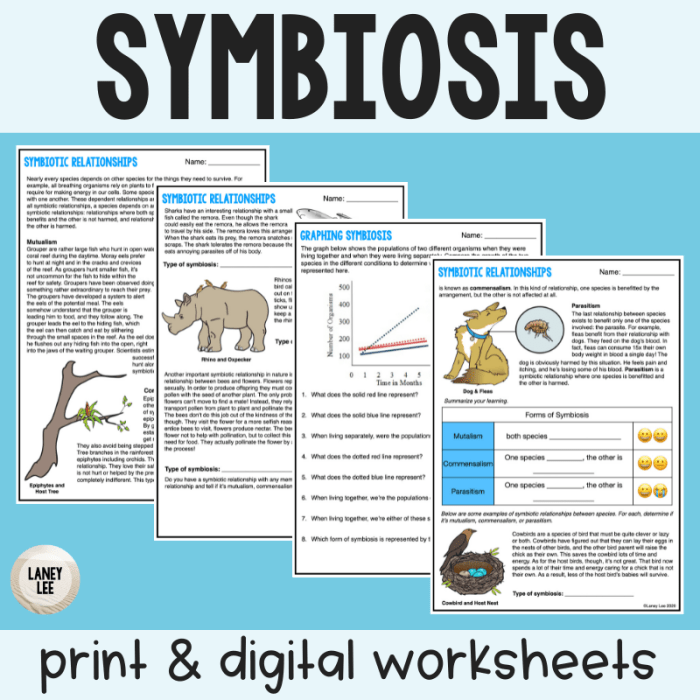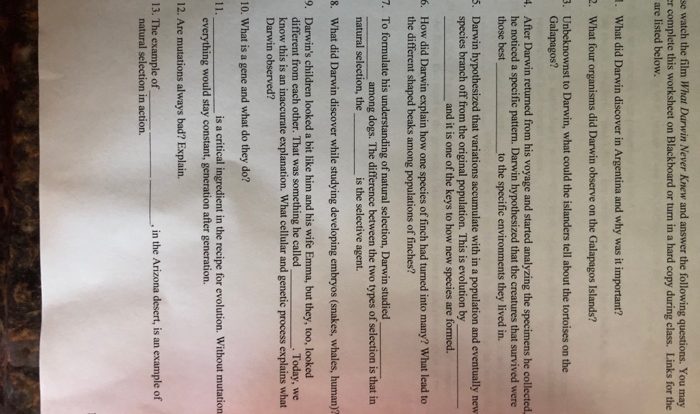The symbiosis worksheet and answer key, an invaluable resource in the study of biology, takes center stage in this comprehensive guide. Delving into the intricate relationships between organisms, this guide unravels the complexities of symbiosis, empowering educators with the tools to foster a deeper understanding of this fascinating topic among their students.
Within this guide, we embark on a journey to explore the diverse types of symbiosis, unraveling the characteristics and benefits that define each. Engaging activities and thought-provoking questions ignite students’ curiosity, while a comprehensive answer key provides clarity and reinforces understanding.
The benefits of incorporating symbiosis worksheets and answer keys into the classroom are illuminated, showcasing their potential to transform biology education.
Symbiosis Worksheet and Answer Key Overview
Symbiosis refers to the close and long-term interaction between two different species. It can be classified into three main types: mutualism, commensalism, and parasitism. A symbiosis worksheet and answer key provide a structured and engaging way for students to learn about these different types of interactions.
Types of Symbiosis

Mutualism
In mutualism, both species benefit from the interaction. An example is the relationship between bees and flowers. Bees collect nectar from flowers for food, while the flowers benefit from pollination, which helps them reproduce.
Commensalism, Symbiosis worksheet and answer key
In commensalism, one species benefits from the interaction, while the other is neither harmed nor benefited. An example is the relationship between barnacles and whales. Barnacles attach themselves to the skin of whales, which provides them with a stable surface to live on, but the whales are not affected by the barnacles.
Parasitism
In parasitism, one species (the parasite) benefits from the interaction, while the other species (the host) is harmed. An example is the relationship between tapeworms and humans. Tapeworms live in the intestines of humans and absorb nutrients from the food that the humans eat, which can lead to malnutrition and other health problems in the host.
Symbiosis Worksheet Activities
Symbiosis worksheets can include a variety of activities to help students understand the concept. These activities may include:
- Matching exercises to match different types of symbiosis with their definitions or examples.
- Diagrams or drawings to illustrate different types of symbiotic relationships.
- Case studies or scenarios to analyze real-world examples of symbiosis.
- Role-playing activities to simulate different types of symbiotic interactions.
Answer Key for Symbiosis Worksheet
An answer key for a symbiosis worksheet is essential for providing students with feedback on their work. The answer key should include clear and concise explanations for each question or activity. It should also provide additional information or resources that students can use to learn more about symbiosis.
Benefits of Using a Symbiosis Worksheet and Answer Key
Using a symbiosis worksheet and answer key in the classroom can provide several benefits, including:
- Enhanced student understanding of symbiosis and its different types.
- Improved critical thinking and problem-solving skills.
- Increased engagement and motivation in learning about ecology and biology.
- A valuable resource for students to review and reinforce their understanding of symbiosis.
FAQ Summary
What is the purpose of a symbiosis worksheet?
Symbiosis worksheets are designed to enhance student understanding of symbiotic relationships between organisms. They provide a structured framework for exploring the different types of symbiosis, their characteristics, and their ecological significance.
How can I effectively use a symbiosis answer key?
An answer key provides correct responses to the questions or activities in a symbiosis worksheet. It serves as a valuable tool for students to check their understanding and for teachers to assess student learning. Clear and concise explanations within the answer key facilitate comprehension and reinforce key concepts.
What are the benefits of using symbiosis worksheets and answer keys in the classroom?
Symbiosis worksheets and answer keys offer numerous benefits in the classroom. They promote active learning, encourage critical thinking, and provide a deeper understanding of ecological relationships. These resources cater to diverse learning styles and can be tailored to various educational settings, making them a versatile tool for biology educators.
